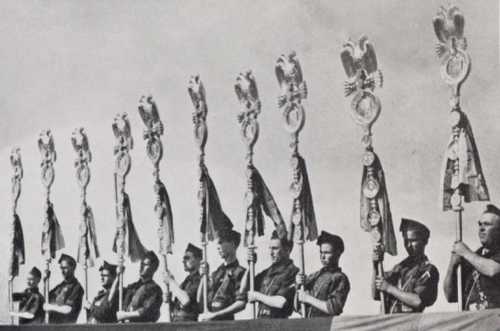
Other Forces
Spanish Falangist standard-bearers.
Members of the Falangist Frente de Juventudes youth movement bearing party standards. The date is somewhat uncertain, but it is very likely to be at a rally preceding the 1936 Spanish general election - in which the Party did very, very badly. The bad performance can be put down in part to a general lack of appeal among the electorate for its radical Fascist agenda, in part to the dislike of this agenda among the Spanish Right in general. The Falange subsequently became a major vehicle for the Francoist counter-revolution, but with its Fascist teeth drawn, and under conditions of a forced, and distinctly uncomfortable, union with the reactionary Carlists. This photograph shows one feature of Fascism that largely survived the "defascistisation" of the Falange - its adoption of outward symbols and trappings of Fascism and Naziism. Like similar German banners in particular, these standards include the colours, versions of the medallions that featured on ancient Roman "vexilla" and, of course, eagles. In this case, the eagle was the double-headed Habsburg eagle, recalling the glorious Spanish Habsburg past of Charles I (as king) and V (as Holy Roman Emperor), and of his son, Philip II. Best regards, JR.
2335 Views
5/16/2013
